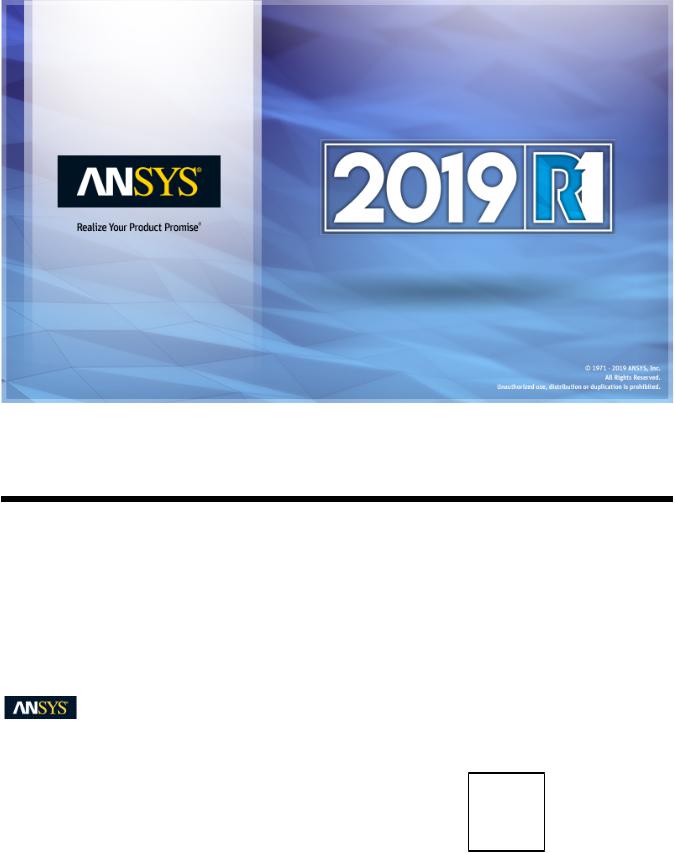
- •ANSYS Fluent Tutorial Guide
- •Table of Contents
- •Using This Manual
- •1. What’s In This Manual
- •2. How To Use This Manual
- •2.1. For the Beginner
- •2.2. For the Experienced User
- •3. Typographical Conventions Used In This Manual
- •Chapter 1: Fluid Flow in an Exhaust Manifold
- •1.1. Introduction
- •1.2. Prerequisites
- •1.3. Problem Description
- •1.4. Setup and Solution
- •1.4.1. Preparation
- •1.4.2. Meshing Workflow
- •1.4.3. General Settings
- •1.4.4. Solver Settings
- •1.4.5. Models
- •1.4.6. Materials
- •1.4.7. Cell Zone Conditions
- •1.4.8. Boundary Conditions
- •1.4.9. Solution
- •1.4.10. Postprocessing
- •1.5. Summary
- •Chapter 2: Fluid Flow and Heat Transfer in a Mixing Elbow
- •2.1. Introduction
- •2.2. Prerequisites
- •2.3. Problem Description
- •2.4. Setup and Solution
- •2.4.1. Preparation
- •2.4.2. Launching ANSYS Fluent
- •2.4.3. Reading the Mesh
- •2.4.4. Setting Up Domain
- •2.4.5. Setting Up Physics
- •2.4.6. Solving
- •2.4.7. Displaying the Preliminary Solution
- •2.4.8. Adapting the Mesh
- •2.5. Summary
- •Chapter 3: Postprocessing
- •3.1. Introduction
- •3.2. Prerequisites
- •3.3. Problem Description
- •3.4. Setup and Solution
- •3.4.1. Preparation
- •3.4.2. Reading the Mesh
- •3.4.3. Manipulating the Mesh in the Viewer
- •3.4.4. Adding Lights
- •3.4.5. Creating Isosurfaces
- •3.4.6. Generating Contours
- •3.4.7. Generating Velocity Vectors
- •3.4.8. Creating an Animation
- •3.4.9. Displaying Pathlines
- •3.4.10. Creating a Scene With Vectors and Contours
- •3.4.11. Advanced Overlay of Pathlines on a Scene
- •3.4.12. Creating Exploded Views
- •3.4.13. Animating the Display of Results in Successive Streamwise Planes
- •3.4.14. Generating XY Plots
- •3.4.15. Creating Annotation
- •3.4.16. Saving Picture Files
- •3.4.17. Generating Volume Integral Reports
- •3.5. Summary
- •Chapter 4: Modeling Periodic Flow and Heat Transfer
- •4.1. Introduction
- •4.2. Prerequisites
- •4.3. Problem Description
- •4.4. Setup and Solution
- •4.4.1. Preparation
- •4.4.2. Mesh
- •4.4.3. General Settings
- •4.4.4. Models
- •4.4.5. Materials
- •4.4.6. Cell Zone Conditions
- •4.4.7. Periodic Conditions
- •4.4.8. Boundary Conditions
- •4.4.9. Solution
- •4.4.10. Postprocessing
- •4.5. Summary
- •4.6. Further Improvements
- •Chapter 5: Modeling External Compressible Flow
- •5.1. Introduction
- •5.2. Prerequisites
- •5.3. Problem Description
- •5.4. Setup and Solution
- •5.4.1. Preparation
- •5.4.2. Mesh
- •5.4.3. Solver
- •5.4.4. Models
- •5.4.5. Materials
- •5.4.6. Boundary Conditions
- •5.4.7. Operating Conditions
- •5.4.8. Solution
- •5.4.9. Postprocessing
- •5.5. Summary
- •5.6. Further Improvements
- •Chapter 6: Modeling Transient Compressible Flow
- •6.1. Introduction
- •6.2. Prerequisites
- •6.3. Problem Description
- •6.4. Setup and Solution
- •6.4.1. Preparation
- •6.4.2. Reading and Checking the Mesh
- •6.4.3. Solver and Analysis Type
- •6.4.4. Models
- •6.4.5. Materials
- •6.4.6. Operating Conditions
- •6.4.7. Boundary Conditions
- •6.4.8. Solution: Steady Flow
- •6.4.9. Enabling Time Dependence and Setting Transient Conditions
- •6.4.10. Specifying Solution Parameters for Transient Flow and Solving
- •6.4.11. Saving and Postprocessing Time-Dependent Data Sets
- •6.5. Summary
- •6.6. Further Improvements
- •Chapter 7: Modeling Flow Through Porous Media
- •7.1. Introduction
- •7.2. Prerequisites
- •7.3. Problem Description
- •7.4. Setup and Solution
- •7.4.1. Preparation
- •7.4.2. Mesh
- •7.4.3. General Settings
- •7.4.4. Models
- •7.4.5. Materials
- •7.4.6. Cell Zone Conditions
- •7.4.7. Boundary Conditions
- •7.4.8. Solution
- •7.4.9. Postprocessing
- •7.5. Summary
- •7.6. Further Improvements
- •Chapter 8: Modeling Radiation and Natural Convection
- •8.1. Introduction
- •8.2. Prerequisites
- •8.3. Problem Description
- •8.4. Setup and Solution
- •8.4.1. Preparation
- •8.4.2. Reading and Checking the Mesh
- •8.4.3. Solver and Analysis Type
- •8.4.4. Models
- •8.4.5. Defining the Materials
- •8.4.6. Operating Conditions
- •8.4.7. Boundary Conditions
- •8.4.8. Obtaining the Solution
- •8.4.9. Postprocessing
- •8.4.10. Comparing the Contour Plots after Varying Radiating Surfaces
- •8.4.11. S2S Definition, Solution, and Postprocessing with Partial Enclosure
- •8.5. Summary
- •8.6. Further Improvements
- •Chapter 9: Using a Single Rotating Reference Frame
- •9.1. Introduction
- •9.2. Prerequisites
- •9.3. Problem Description
- •9.4. Setup and Solution
- •9.4.1. Preparation
- •9.4.2. Mesh
- •9.4.3. General Settings
- •9.4.4. Models
- •9.4.5. Materials
- •9.4.6. Cell Zone Conditions
- •9.4.7. Boundary Conditions
- •9.4.8. Solution Using the Standard k- ε Model
- •9.4.9. Postprocessing for the Standard k- ε Solution
- •9.4.10. Solution Using the RNG k- ε Model
- •9.4.11. Postprocessing for the RNG k- ε Solution
- •9.5. Summary
- •9.6. Further Improvements
- •9.7. References
- •Chapter 10: Using Multiple Reference Frames
- •10.1. Introduction
- •10.2. Prerequisites
- •10.3. Problem Description
- •10.4. Setup and Solution
- •10.4.1. Preparation
- •10.4.2. Mesh
- •10.4.3. Models
- •10.4.4. Materials
- •10.4.5. Cell Zone Conditions
- •10.4.6. Boundary Conditions
- •10.4.7. Solution
- •10.4.8. Postprocessing
- •10.5. Summary
- •10.6. Further Improvements
- •Chapter 11: Using Sliding Meshes
- •11.1. Introduction
- •11.2. Prerequisites
- •11.3. Problem Description
- •11.4. Setup and Solution
- •11.4.1. Preparation
- •11.4.2. Mesh
- •11.4.3. General Settings
- •11.4.4. Models
- •11.4.5. Materials
- •11.4.6. Cell Zone Conditions
- •11.4.7. Boundary Conditions
- •11.4.8. Operating Conditions
- •11.4.9. Mesh Interfaces
- •11.4.10. Solution
- •11.4.11. Postprocessing
- •11.5. Summary
- •11.6. Further Improvements
- •Chapter 12: Using Overset and Dynamic Meshes
- •12.1. Prerequisites
- •12.2. Problem Description
- •12.3. Preparation
- •12.4. Mesh
- •12.5. Overset Interface Creation
- •12.6. Steady-State Case Setup
- •12.6.1. General Settings
- •12.6.2. Models
- •12.6.3. Materials
- •12.6.4. Operating Conditions
- •12.6.5. Boundary Conditions
- •12.6.6. Reference Values
- •12.6.7. Solution
- •12.7. Unsteady Setup
- •12.7.1. General Settings
- •12.7.2. Compile the UDF
- •12.7.3. Dynamic Mesh Settings
- •12.7.4. Report Generation for Unsteady Case
- •12.7.5. Run Calculations for Unsteady Case
- •12.7.6. Overset Solution Checking
- •12.7.7. Postprocessing
- •12.7.8. Diagnosing an Overset Case
- •12.8. Summary
- •Chapter 13: Modeling Species Transport and Gaseous Combustion
- •13.1. Introduction
- •13.2. Prerequisites
- •13.3. Problem Description
- •13.4. Background
- •13.5. Setup and Solution
- •13.5.1. Preparation
- •13.5.2. Mesh
- •13.5.3. General Settings
- •13.5.4. Models
- •13.5.5. Materials
- •13.5.6. Boundary Conditions
- •13.5.7. Initial Reaction Solution
- •13.5.8. Postprocessing
- •13.5.9. NOx Prediction
- •13.6. Summary
- •13.7. Further Improvements
- •Chapter 14: Using the Eddy Dissipation and Steady Diffusion Flamelet Combustion Models
- •14.1. Introduction
- •14.2. Prerequisites
- •14.3. Problem Description
- •14.4. Setup and Solution
- •14.4.1. Preparation
- •14.4.2. Mesh
- •14.4.3. Solver Settings
- •14.4.4. Models
- •14.4.5. Boundary Conditions
- •14.4.6. Solution
- •14.4.7. Postprocessing for the Eddy-Dissipation Solution
- •14.5. Steady Diffusion Flamelet Model Setup and Solution
- •14.5.1. Models
- •14.5.2. Boundary Conditions
- •14.5.3. Solution
- •14.5.4. Postprocessing for the Steady Diffusion Flamelet Solution
- •14.6. Summary
- •Chapter 15: Modeling Surface Chemistry
- •15.1. Introduction
- •15.2. Prerequisites
- •15.3. Problem Description
- •15.4. Setup and Solution
- •15.4.1. Preparation
- •15.4.2. Reading and Checking the Mesh
- •15.4.3. Solver and Analysis Type
- •15.4.4. Specifying the Models
- •15.4.5. Defining Materials and Properties
- •15.4.6. Specifying Boundary Conditions
- •15.4.7. Setting the Operating Conditions
- •15.4.8. Simulating Non-Reacting Flow
- •15.4.9. Simulating Reacting Flow
- •15.4.10. Postprocessing the Solution Results
- •15.5. Summary
- •15.6. Further Improvements
- •Chapter 16: Modeling Evaporating Liquid Spray
- •16.1. Introduction
- •16.2. Prerequisites
- •16.3. Problem Description
- •16.4. Setup and Solution
- •16.4.1. Preparation
- •16.4.2. Mesh
- •16.4.3. Solver
- •16.4.4. Models
- •16.4.5. Materials
- •16.4.6. Boundary Conditions
- •16.4.7. Initial Solution Without Droplets
- •16.4.8. Creating a Spray Injection
- •16.4.9. Solution
- •16.4.10. Postprocessing
- •16.5. Summary
- •16.6. Further Improvements
- •Chapter 17: Using the VOF Model
- •17.1. Introduction
- •17.2. Prerequisites
- •17.3. Problem Description
- •17.4. Setup and Solution
- •17.4.1. Preparation
- •17.4.2. Reading and Manipulating the Mesh
- •17.4.3. General Settings
- •17.4.4. Models
- •17.4.5. Materials
- •17.4.6. Phases
- •17.4.7. Operating Conditions
- •17.4.8. User-Defined Function (UDF)
- •17.4.9. Boundary Conditions
- •17.4.10. Solution
- •17.4.11. Postprocessing
- •17.5. Summary
- •17.6. Further Improvements
- •Chapter 18: Modeling Cavitation
- •18.1. Introduction
- •18.2. Prerequisites
- •18.3. Problem Description
- •18.4. Setup and Solution
- •18.4.1. Preparation
- •18.4.2. Reading and Checking the Mesh
- •18.4.3. Solver Settings
- •18.4.4. Models
- •18.4.5. Materials
- •18.4.6. Phases
- •18.4.7. Boundary Conditions
- •18.4.8. Operating Conditions
- •18.4.9. Solution
- •18.4.10. Postprocessing
- •18.5. Summary
- •18.6. Further Improvements
- •Chapter 19: Using the Multiphase Models
- •19.1. Introduction
- •19.2. Prerequisites
- •19.3. Problem Description
- •19.4. Setup and Solution
- •19.4.1. Preparation
- •19.4.2. Mesh
- •19.4.3. Solver Settings
- •19.4.4. Models
- •19.4.5. Materials
- •19.4.6. Phases
- •19.4.7. Cell Zone Conditions
- •19.4.8. Boundary Conditions
- •19.4.9. Solution
- •19.4.10. Postprocessing
- •19.5. Summary
- •Chapter 20: Modeling Solidification
- •20.1. Introduction
- •20.2. Prerequisites
- •20.3. Problem Description
- •20.4. Setup and Solution
- •20.4.1. Preparation
- •20.4.2. Reading and Checking the Mesh
- •20.4.3. Specifying Solver and Analysis Type
- •20.4.4. Specifying the Models
- •20.4.5. Defining Materials
- •20.4.6. Setting the Cell Zone Conditions
- •20.4.7. Setting the Boundary Conditions
- •20.4.8. Solution: Steady Conduction
- •20.5. Summary
- •20.6. Further Improvements
- •Chapter 21: Using the Eulerian Granular Multiphase Model with Heat Transfer
- •21.1. Introduction
- •21.2. Prerequisites
- •21.3. Problem Description
- •21.4. Setup and Solution
- •21.4.1. Preparation
- •21.4.2. Mesh
- •21.4.3. Solver Settings
- •21.4.4. Models
- •21.4.6. Materials
- •21.4.7. Phases
- •21.4.8. Boundary Conditions
- •21.4.9. Solution
- •21.4.10. Postprocessing
- •21.5. Summary
- •21.6. Further Improvements
- •21.7. References
- •22.1. Introduction
- •22.2. Prerequisites
- •22.3. Problem Description
- •22.4. Setup and Solution
- •22.4.1. Preparation
- •22.4.2. Structural Model
- •22.4.3. Materials
- •22.4.4. Cell Zone Conditions
- •22.4.5. Boundary Conditions
- •22.4.6. Solution
- •22.4.7. Postprocessing
- •22.5. Summary
- •23.1. Introduction
- •23.2. Prerequisites
- •23.3. Problem Description
- •23.4. Setup and Solution
- •23.4.1. Preparation
- •23.4.2. Solver and Analysis Type
- •23.4.3. Structural Model
- •23.4.4. Materials
- •23.4.5. Cell Zone Conditions
- •23.4.6. Boundary Conditions
- •23.4.7. Dynamic Mesh Zones
- •23.4.8. Solution Animations
- •23.4.9. Solution
- •23.4.10. Postprocessing
- •23.5. Summary
- •Chapter 24: Using the Adjoint Solver – 2D Laminar Flow Past a Cylinder
- •24.1. Introduction
- •24.2. Prerequisites
- •24.3. Problem Description
- •24.4. Setup and Solution
- •24.4.1. Step 1: Preparation
- •24.4.2. Step 2: Define Observables
- •24.4.3. Step 3: Compute the Drag Sensitivity
- •24.4.4. Step 4: Postprocess and Export Drag Sensitivity
- •24.4.4.1. Boundary Condition Sensitivity
- •24.4.4.2. Momentum Source Sensitivity
- •24.4.4.3. Shape Sensitivity
- •24.4.4.4. Exporting Drag Sensitivity Data
- •24.4.5. Step 5: Compute Lift Sensitivity
- •24.4.6. Step 6: Modify the Shape
- •24.5. Summary
- •25.1. Introduction
- •25.2. Prerequisites
- •25.3. Problem Description
- •25.4. Setup and Solution
- •25.4.1. Preparation
- •25.4.2. Reading and Scaling the Mesh
- •25.4.3. Loading the MSMD battery Add-on
- •25.4.4. NTGK Battery Model Setup
- •25.4.4.1. Specifying Solver and Models
- •25.4.4.2. Defining New Materials for Cell and Tabs
- •25.4.4.3. Defining Cell Zone Conditions
- •25.4.4.4. Defining Boundary Conditions
- •25.4.4.5. Specifying Solution Settings
- •25.4.4.6. Obtaining Solution
- •25.4.5. Postprocessing
- •25.4.6. Simulating the Battery Pulse Discharge Using the ECM Model
- •25.4.7. Using the Reduced Order Method (ROM)
- •25.4.8. External and Internal Short-Circuit Treatment
- •25.4.8.1. Setting up and Solving a Short-Circuit Problem
- •25.4.8.2. Postprocessing
- •25.5. Summary
- •25.6. Appendix
- •25.7. References
- •26.1. Introduction
- •26.2. Prerequisites
- •26.3. Problem Description
- •26.4. Setup and Solution
- •26.4.1. Preparation
- •26.4.2. Reading and Scaling the Mesh
- •26.4.3. Loading the MSMD battery Add-on
- •26.4.4. Battery Model Setup
- •26.4.4.1. Specifying Solver and Models
- •26.4.4.2. Defining New Materials
- •26.4.4.3. Defining Cell Zone Conditions
- •26.4.4.4. Defining Boundary Conditions
- •26.4.4.5. Specifying Solution Settings
- •26.4.4.6. Obtaining Solution
- •26.4.5. Postprocessing
- •26.5. Summary
- •Chapter 27: In-Flight Icing Tutorial Using Fluent Icing
- •27.1. Fluent Airflow on the NACA0012 Airfoil
- •27.2. Flow Solution on the Rough NACA0012 Airfoil
- •27.3. Droplet Impingement on the NACA0012
- •27.3.1. Monodispersed Calculation
- •27.3.2. Langmuir-D Distribution
- •27.3.3. Post-Processing Using Quick-View
- •27.4. Fluent Icing Ice Accretion on the NACA0012
- •27.5. Postprocessing an Ice Accretion Solution Using CFD-Post Macros
- •27.6. Multi-Shot Ice Accretion with Automatic Mesh Displacement
- •27.7. Multi-Shot Ice Accretion with Automatic Mesh Displacement – Postprocessing Using CFD-Post

vk.com/club152685050 | vk.com/id446425943
ANSYS Fluent Tutorial Guide
ANSYS, Inc. |
Release 2019 R1 |
|
Southpointe |
January 2019 |
|
2600 ANSYS Drive |
|
|
Canonsburg, PA 15317 |
ANSYS, Inc. and |
|
ansysinfo@ansys.com |
ANSYS Europe, |
|
http://www.ansys.com |
Ltd. are UL |
|
registered ISO |
||
(T) 724-746-3304 |
||
9001: 2015 |
||
(F) 724-514-9494 |
companies. |

vk.com/club152685050 | vk.com/id446425943
Copyright and Trademark Information
© 2018 ANSYS, Inc. Unauthorized use, distribution or duplication is prohibited.
ANSYS, ANSYS Workbench, AUTODYN, CFX, FLUENT and any and all ANSYS, Inc. brand, product, service and feature names, logos and slogans are registered trademarks or trademarks of ANSYS, Inc. or its subsidiaries located in the United States or other countries. ICEM CFD is a trademark used by ANSYS, Inc. under license. CFX is a trademark of Sony Corporation in Japan. All other brand, product, service and feature names or trademarks are the property of their respective owners. FLEXlm and FLEXnet are trademarks of Flexera Software LLC.
Disclaimer Notice
THIS ANSYS SOFTWARE PRODUCT AND PROGRAM DOCUMENTATION INCLUDE TRADE SECRETS AND ARE CONFIDENTIAL AND PROPRIETARY PRODUCTS OF ANSYS, INC., ITS SUBSIDIARIES, OR LICENSORS. The software products and documentation are furnished by ANSYS, Inc., its subsidiaries, or affiliates under a software license agreement that contains provisions concerning non-disclosure, copying, length and nature of use, compliance with exporting laws, warranties, disclaimers, limitations of liability, and remedies, and other provisions. The software products
and documentation may be used, disclosed, transferred, or copied only in accordance with the terms and conditions of that software license agreement.
ANSYS, Inc. and ANSYS Europe, Ltd. are UL registered ISO 9001: 2015 companies.
U.S. Government Rights
For U.S. Government users, except as specifically granted by the ANSYS, Inc. software license agreement, the use, duplication, or disclosure by the United States Government is subject to restrictions stated in the ANSYS, Inc. software license agreement and FAR 12.212 (for non-DOD licenses).
Third-Party Software
See the legal information in the product help files for the complete Legal Notice for ANSYS proprietary software and third-party software. If you are unable to access the Legal Notice, contact ANSYS, Inc.
Published in the U.S.A.

vk.com/club152685050 | vk.com/id446425943
Table of Contents |
|
Using This Manual ...................................................................................................................................... |
xxi |
1. What’s In This Manual ........................................................................................................................ |
xxi |
2. How To Use This Manual .................................................................................................................... |
xxi |
2.1. For the Beginner ....................................................................................................................... |
xxi |
2.2. For the Experienced User .......................................................................................................... |
xxi |
3.Typographical Conventions Used In This Manual ................................................................................ |
xxi |
1. Fluid Flow in an Exhaust Manifold .......................................................................................................... |
1 |
1.1. Introduction ..................................................................................................................................... |
1 |
1.2. Prerequisites ..................................................................................................................................... |
2 |
1.3. Problem Description ......................................................................................................................... |
2 |
1.4. Setup and Solution ........................................................................................................................... |
2 |
1.4.1. Preparation .............................................................................................................................. |
3 |
1.4.2. Meshing Workflow ................................................................................................................... |
3 |
1.4.3. General Settings ..................................................................................................................... |
15 |
1.4.4. Solver Settings ....................................................................................................................... |
15 |
1.4.5. Models ................................................................................................................................... |
16 |
1.4.6. Materials ................................................................................................................................ |
16 |
1.4.7. Cell Zone Conditions .............................................................................................................. |
16 |
1.4.8. Boundary Conditions ............................................................................................................. |
17 |
1.4.9. Solution ................................................................................................................................. |
19 |
1.4.10. Postprocessing ..................................................................................................................... |
26 |
1.5. Summary ........................................................................................................................................ |
33 |
2. Fluid Flow and Heat Transfer in a Mixing Elbow ................................................................................... |
35 |
2.1. Introduction ................................................................................................................................... |
35 |
2.2. Prerequisites ................................................................................................................................... |
35 |
2.3. Problem Description ....................................................................................................................... |
35 |
2.4. Setup and Solution ......................................................................................................................... |
36 |
2.4.1. Preparation ............................................................................................................................ |
37 |
2.4.2. Launching ANSYS Fluent ........................................................................................................ |
37 |
2.4.3. Reading the Mesh .................................................................................................................. |
40 |
2.4.4. Setting Up Domain ................................................................................................................. |
43 |
2.4.5. Setting Up Physics .................................................................................................................. |
46 |
2.4.6. Solving .................................................................................................................................. |
58 |
2.4.7. Displaying the Preliminary Solution ........................................................................................ |
68 |
2.4.8. Adapting the Mesh ................................................................................................................. |
80 |
2.5. Summary ........................................................................................................................................ |
93 |
3. Postprocessing ...................................................................................................................................... |
95 |
3.1. Introduction ................................................................................................................................... |
95 |
3.2. Prerequisites ................................................................................................................................... |
96 |
3.3. Problem Description ....................................................................................................................... |
96 |
3.4. Setup and Solution ......................................................................................................................... |
96 |
3.4.1. Preparation ............................................................................................................................ |
97 |
3.4.2. Reading the Mesh .................................................................................................................. |
97 |
3.4.3. Manipulating the Mesh in the Viewer ...................................................................................... |
97 |
3.4.4. Adding Lights ........................................................................................................................ |
99 |
3.4.5. Creating Isosurfaces ............................................................................................................. |
103 |
3.4.6. Generating Contours ............................................................................................................ |
106 |
3.4.7. Generating Velocity Vectors .................................................................................................. |
110 |
3.4.8. Creating an Animation ......................................................................................................... |
115 |
3.4.9. Displaying Pathlines ............................................................................................................. |
119 |
Release 2019 R1 - © ANSYS,Inc.All rights reserved.- Contains proprietary and confidential information |
|
of ANSYS, Inc. and its subsidiaries and affiliates. |
iii |

vk.com/club152685050Tutorial Guide | vk.com/id446425943
3.4.10. Creating a Scene With Vectors and Contours ....................................................................... |
124 |
3.4.11. Advanced Overlay of Pathlines on a Scene .......................................................................... |
126 |
3.4.12. Creating Exploded Views .................................................................................................... |
128 |
3.4.13. Animating the Display of Results in Successive Streamwise Planes ....................................... |
133 |
3.4.14. Generating XY Plots ............................................................................................................ |
135 |
3.4.15. Creating Annotation ........................................................................................................... |
138 |
3.4.16. Saving Picture Files ............................................................................................................. |
140 |
3.4.17. Generating Volume Integral Reports ................................................................................... |
141 |
3.5. Summary ...................................................................................................................................... |
141 |
4. Modeling Periodic Flow and Heat Transfer ......................................................................................... |
143 |
4.1. Introduction ................................................................................................................................. |
143 |
4.2. Prerequisites ................................................................................................................................. |
143 |
4.3. Problem Description ..................................................................................................................... |
144 |
4.4. Setup and Solution ....................................................................................................................... |
144 |
4.4.1. Preparation .......................................................................................................................... |
145 |
4.4.2. Mesh .................................................................................................................................... |
145 |
4.4.3. General Settings ................................................................................................................... |
148 |
4.4.4. Models ................................................................................................................................. |
148 |
4.4.5. Materials .............................................................................................................................. |
148 |
4.4.6. Cell Zone Conditions ............................................................................................................ |
150 |
4.4.7. Periodic Conditions .............................................................................................................. |
151 |
4.4.8. Boundary Conditions ............................................................................................................ |
151 |
4.4.9. Solution ............................................................................................................................... |
152 |
4.4.10. Postprocessing ................................................................................................................... |
157 |
4.5. Summary ...................................................................................................................................... |
165 |
4.6. Further Improvements .................................................................................................................. |
165 |
5. Modeling External Compressible Flow ............................................................................................... |
167 |
5.1. Introduction ................................................................................................................................. |
167 |
5.2. Prerequisites ................................................................................................................................. |
167 |
5.3. Problem Description ..................................................................................................................... |
167 |
5.4. Setup and Solution ....................................................................................................................... |
168 |
5.4.1. Preparation .......................................................................................................................... |
168 |
5.4.2. Mesh .................................................................................................................................... |
168 |
5.4.3. Solver .................................................................................................................................. |
170 |
5.4.4. Models ................................................................................................................................. |
170 |
5.4.5. Materials .............................................................................................................................. |
171 |
5.4.6. Boundary Conditions ............................................................................................................ |
173 |
5.4.7. Operating Conditions ........................................................................................................... |
176 |
5.4.8. Solution ............................................................................................................................... |
177 |
5.4.9. Postprocessing ..................................................................................................................... |
192 |
5.5. Summary ...................................................................................................................................... |
197 |
5.6. Further Improvements .................................................................................................................. |
197 |
6. Modeling Transient Compressible Flow .............................................................................................. |
199 |
6.1. Introduction ................................................................................................................................. |
199 |
6.2. Prerequisites ................................................................................................................................. |
199 |
6.3. Problem Description ..................................................................................................................... |
199 |
6.4. Setup and Solution ....................................................................................................................... |
200 |
6.4.1. Preparation .......................................................................................................................... |
200 |
6.4.2. Reading and Checking the Mesh ........................................................................................... |
200 |
6.4.3. Solver and Analysis Type ....................................................................................................... |
203 |
6.4.4. Models ................................................................................................................................. |
204 |
6.4.5. Materials .............................................................................................................................. |
205 |
|
Release 2019 R1 - © ANSYS,Inc.All rights reserved.- Contains proprietary and confidential information |
iv |
of ANSYS, Inc. and its subsidiaries and affiliates. |

vk.com/club152685050 | vk.com/id446425943 |
Tutorial Guide |
6.4.6. Operating Conditions ........................................................................................................... |
205 |
6.4.7. Boundary Conditions ............................................................................................................ |
206 |
6.4.8. Solution: Steady Flow ........................................................................................................... |
209 |
6.4.9. Enabling Time Dependence and Setting Transient Conditions ............................................... |
224 |
6.4.10. Specifying Solution Parameters for Transient Flow and Solving ............................................ |
226 |
6.4.11. Saving and Postprocessing Time-Dependent Data Sets ....................................................... |
230 |
6.5. Summary ...................................................................................................................................... |
242 |
6.6. Further Improvements .................................................................................................................. |
242 |
7. Modeling Flow Through Porous Media ............................................................................................... |
243 |
7.1. Introduction ................................................................................................................................. |
243 |
7.2. Prerequisites ................................................................................................................................. |
243 |
7.3. Problem Description ..................................................................................................................... |
244 |
7.4. Setup and Solution ....................................................................................................................... |
244 |
7.4.1. Preparation .......................................................................................................................... |
244 |
7.4.2. Mesh .................................................................................................................................... |
245 |
7.4.3. General Settings ................................................................................................................... |
247 |
7.4.4. Models ................................................................................................................................. |
247 |
7.4.5. Materials .............................................................................................................................. |
248 |
7.4.6. Cell Zone Conditions ............................................................................................................ |
250 |
7.4.7. Boundary Conditions ............................................................................................................ |
253 |
7.4.8. Solution ............................................................................................................................... |
256 |
7.4.9. Postprocessing ..................................................................................................................... |
261 |
7.5. Summary ...................................................................................................................................... |
276 |
7.6. Further Improvements .................................................................................................................. |
276 |
8. Modeling Radiation and Natural Convection ..................................................................................... |
277 |
8.1. Introduction ................................................................................................................................. |
277 |
8.2. Prerequisites ................................................................................................................................. |
277 |
8.3. Problem Description ..................................................................................................................... |
277 |
8.4. Setup and Solution ....................................................................................................................... |
278 |
8.4.1. Preparation .......................................................................................................................... |
278 |
8.4.2. Reading and Checking the Mesh ........................................................................................... |
279 |
8.4.3. Solver and Analysis Type ....................................................................................................... |
279 |
8.4.4. Models ................................................................................................................................. |
280 |
8.4.5. Defining the Materials .......................................................................................................... |
284 |
8.4.6. Operating Conditions ........................................................................................................... |
285 |
8.4.7. Boundary Conditions ............................................................................................................ |
286 |
8.4.8. Obtaining the Solution ......................................................................................................... |
291 |
8.4.9. Postprocessing ..................................................................................................................... |
298 |
8.4.10. Comparing the Contour Plots after Varying Radiating Surfaces ............................................ |
310 |
8.4.11. S2S Definition, Solution, and Postprocessing with Partial Enclosure ...................................... |
315 |
8.5. Summary ...................................................................................................................................... |
318 |
8.6. Further Improvements .................................................................................................................. |
318 |
9. Using a Single Rotating Reference Frame ........................................................................................... |
319 |
9.1. Introduction ................................................................................................................................. |
319 |
9.2. Prerequisites ................................................................................................................................. |
319 |
9.3. Problem Description ..................................................................................................................... |
319 |
9.4. Setup and Solution ....................................................................................................................... |
320 |
9.4.1. Preparation .......................................................................................................................... |
321 |
9.4.2. Mesh .................................................................................................................................... |
321 |
9.4.3. General Settings ................................................................................................................... |
321 |
9.4.4. Models ................................................................................................................................. |
323 |
9.4.5. Materials .............................................................................................................................. |
325 |
Release 2019 R1 - © ANSYS,Inc.All rights reserved.- Contains proprietary and confidential information |
|
of ANSYS, Inc. and its subsidiaries and affiliates. |
v |

vk.com/club152685050Tutorial Guide | vk.com/id446425943
9.4.6. Cell Zone Conditions ............................................................................................................ |
325 |
9.4.7. Boundary Conditions ............................................................................................................ |
327 |
9.4.8. Solution Using the Standard k- ε Model ................................................................................. |
329 |
9.4.9. Postprocessing for the Standard k- ε Solution ........................................................................ |
336 |
9.4.10. Solution Using the RNG k- ε Model ...................................................................................... |
345 |
9.4.11. Postprocessing for the RNG k- ε Solution ............................................................................. |
347 |
9.5. Summary ...................................................................................................................................... |
352 |
9.6. Further Improvements .................................................................................................................. |
352 |
9.7. References .................................................................................................................................... |
353 |
10. Using Multiple Reference Frames ..................................................................................................... |
355 |
10.1. Introduction ............................................................................................................................... |
355 |
10.2. Prerequisites ............................................................................................................................... |
355 |
10.3. Problem Description ................................................................................................................... |
355 |
10.4. Setup and Solution ..................................................................................................................... |
356 |
10.4.1. Preparation ........................................................................................................................ |
356 |
10.4.2. Mesh .................................................................................................................................. |
357 |
10.4.3. Models ............................................................................................................................... |
357 |
10.4.4. Materials ............................................................................................................................ |
358 |
10.4.5. Cell Zone Conditions .......................................................................................................... |
358 |
10.4.6. Boundary Conditions .......................................................................................................... |
358 |
10.4.7. Solution ............................................................................................................................. |
360 |
10.4.8. Postprocessing ................................................................................................................... |
363 |
10.5. Summary .................................................................................................................................... |
364 |
10.6. Further Improvements ................................................................................................................ |
365 |
11. Using Sliding Meshes ........................................................................................................................ |
367 |
11.1. Introduction ............................................................................................................................... |
367 |
11.2. Prerequisites ............................................................................................................................... |
367 |
11.3. Problem Description ................................................................................................................... |
367 |
11.4. Setup and Solution ..................................................................................................................... |
368 |
11.4.1. Preparation ........................................................................................................................ |
368 |
11.4.2. Mesh .................................................................................................................................. |
369 |
11.4.3. General Settings ................................................................................................................. |
369 |
11.4.4. Models ............................................................................................................................... |
372 |
11.4.5. Materials ............................................................................................................................ |
372 |
11.4.6. Cell Zone Conditions .......................................................................................................... |
373 |
11.4.7. Boundary Conditions .......................................................................................................... |
376 |
11.4.8. Operating Conditions ......................................................................................................... |
382 |
11.4.9. Mesh Interfaces .................................................................................................................. |
382 |
11.4.10. Solution ........................................................................................................................... |
384 |
11.4.11. Postprocessing ................................................................................................................. |
402 |
11.5. Summary .................................................................................................................................... |
406 |
11.6. Further Improvements ................................................................................................................ |
406 |
12. Using Overset and Dynamic Meshes ................................................................................................. |
407 |
12.1. Prerequisites ............................................................................................................................... |
408 |
12.2. Problem Description ................................................................................................................... |
408 |
12.3. Preparation ................................................................................................................................. |
409 |
12.4. Mesh .......................................................................................................................................... |
409 |
12.5. Overset Interface Creation ........................................................................................................... |
412 |
12.6. Steady-State Case Setup .............................................................................................................. |
415 |
12.6.1. General Settings ................................................................................................................. |
415 |
12.6.2. Models ............................................................................................................................... |
415 |
12.6.3. Materials ............................................................................................................................ |
417 |
|
Release 2019 R1 - © ANSYS,Inc.All rights reserved.- Contains proprietary and confidential information |
vi |
of ANSYS, Inc. and its subsidiaries and affiliates. |

vk.com/club152685050 | vk.com/id446425943 |
Tutorial Guide |
12.6.4. Operating Conditions ......................................................................................................... |
417 |
12.6.5. Boundary Conditions .......................................................................................................... |
417 |
12.6.6. Reference Values ................................................................................................................ |
419 |
12.6.7. Solution ............................................................................................................................. |
419 |
12.7. Unsteady Setup .......................................................................................................................... |
425 |
12.7.1. General Settings ................................................................................................................. |
425 |
12.7.2. Compile the UDF ................................................................................................................ |
425 |
12.7.3. Dynamic Mesh Settings ...................................................................................................... |
426 |
12.7.4. Report Generation for Unsteady Case ................................................................................. |
429 |
12.7.5. Run Calculations for Unsteady Case .................................................................................... |
430 |
12.7.6. Overset Solution Checking ................................................................................................. |
431 |
12.7.7. Postprocessing ................................................................................................................... |
431 |
12.7.8. Diagnosing an Overset Case ............................................................................................... |
434 |
12.8. Summary .................................................................................................................................... |
441 |
13. Modeling Species Transport and Gaseous Combustion ................................................................... |
443 |
13.1. Introduction ............................................................................................................................... |
443 |
13.2. Prerequisites ............................................................................................................................... |
443 |
13.3. Problem Description ................................................................................................................... |
443 |
13.4. Background ................................................................................................................................ |
444 |
13.5. Setup and Solution ..................................................................................................................... |
444 |
13.5.1. Preparation ........................................................................................................................ |
444 |
13.5.2. Mesh .................................................................................................................................. |
445 |
13.5.3. General Settings ................................................................................................................. |
445 |
13.5.4. Models ............................................................................................................................... |
447 |
13.5.5. Materials ............................................................................................................................ |
450 |
13.5.6. Boundary Conditions .......................................................................................................... |
453 |
13.5.7. Initial Reaction Solution ...................................................................................................... |
459 |
13.5.8. Postprocessing ................................................................................................................... |
463 |
13.5.9. NOx Prediction ................................................................................................................... |
470 |
13.6. Summary .................................................................................................................................... |
479 |
13.7. Further Improvements ................................................................................................................ |
479 |
14. Using the Eddy Dissipation and Steady Diffusion Flamelet Combustion Models ............................ |
481 |
14.1. Introduction ............................................................................................................................... |
481 |
14.2. Prerequisites ............................................................................................................................... |
481 |
14.3. Problem Description ................................................................................................................... |
481 |
14.4. Setup and Solution ..................................................................................................................... |
482 |
14.4.1. Preparation ........................................................................................................................ |
483 |
14.4.2. Mesh .................................................................................................................................. |
483 |
14.4.3. Solver Settings ................................................................................................................... |
484 |
14.4.4. Models ............................................................................................................................... |
484 |
14.4.5. Boundary Conditions .......................................................................................................... |
485 |
14.4.6. Solution ............................................................................................................................. |
487 |
14.4.7. Postprocessing for the Eddy-Dissipation Solution ................................................................ |
489 |
14.5. Steady Diffusion Flamelet Model Setup and Solution ................................................................... |
495 |
14.5.1. Models ............................................................................................................................... |
496 |
14.5.2. Boundary Conditions .......................................................................................................... |
497 |
14.5.3. Solution ............................................................................................................................. |
498 |
14.5.4. Postprocessing for the Steady Diffusion Flamelet Solution ................................................... |
498 |
14.6. Summary .................................................................................................................................... |
501 |
15. Modeling Surface Chemistry ............................................................................................................. |
503 |
15.1. Introduction ............................................................................................................................... |
503 |
15.2. Prerequisites ............................................................................................................................... |
503 |
Release 2019 R1 - © ANSYS,Inc.All rights reserved.- Contains proprietary and confidential information |
|
of ANSYS, Inc. and its subsidiaries and affiliates. |
vii |

vk.com/club152685050Tutorial Guide | vk.com/id446425943
15.3. Problem Description ................................................................................................................... |
504 |
15.4. Setup and Solution ..................................................................................................................... |
505 |
15.4.1. Preparation ........................................................................................................................ |
505 |
15.4.2. Reading and Checking the Mesh ......................................................................................... |
505 |
15.4.3. Solver and Analysis Type ..................................................................................................... |
507 |
15.4.4. Specifying the Models ........................................................................................................ |
507 |
15.4.5. Defining Materials and Properties ....................................................................................... |
509 |
15.4.6. Specifying Boundary Conditions ......................................................................................... |
520 |
15.4.7. Setting the Operating Conditions ....................................................................................... |
527 |
15.4.8. Simulating Non-Reacting Flow ............................................................................................ |
528 |
15.4.9. Simulating Reacting Flow ................................................................................................... |
530 |
15.4.10. Postprocessing the Solution Results .................................................................................. |
536 |
15.5. Summary .................................................................................................................................... |
542 |
15.6. Further Improvements ................................................................................................................ |
542 |
16. Modeling Evaporating Liquid Spray ................................................................................................. |
543 |
16.1. Introduction ............................................................................................................................... |
543 |
16.2. Prerequisites ............................................................................................................................... |
543 |
16.3. Problem Description ................................................................................................................... |
543 |
16.4. Setup and Solution ..................................................................................................................... |
544 |
16.4.1. Preparation ........................................................................................................................ |
544 |
16.4.2. Mesh .................................................................................................................................. |
545 |
16.4.3. Solver ................................................................................................................................. |
548 |
16.4.4. Models ............................................................................................................................... |
548 |
16.4.5. Materials ............................................................................................................................ |
551 |
16.4.6. Boundary Conditions .......................................................................................................... |
552 |
16.4.7. Initial Solution Without Droplets ......................................................................................... |
558 |
16.4.8. Creating a Spray Injection ................................................................................................... |
568 |
16.4.9. Solution ............................................................................................................................. |
577 |
16.4.10. Postprocessing ................................................................................................................. |
586 |
16.5. Summary .................................................................................................................................... |
596 |
16.6. Further Improvements ................................................................................................................ |
596 |
17. Using the VOF Model ......................................................................................................................... |
597 |
17.1. Introduction ............................................................................................................................... |
597 |
17.2. Prerequisites ............................................................................................................................... |
597 |
17.3. Problem Description ................................................................................................................... |
597 |
17.4. Setup and Solution ..................................................................................................................... |
599 |
17.4.1. Preparation ........................................................................................................................ |
599 |
17.4.2. Reading and Manipulating the Mesh ................................................................................... |
600 |
17.4.3. General Settings ................................................................................................................. |
604 |
17.4.4. Models ............................................................................................................................... |
606 |
17.4.5. Materials ............................................................................................................................ |
607 |
17.4.6. Phases ................................................................................................................................ |
609 |
17.4.7. Operating Conditions ......................................................................................................... |
612 |
17.4.8. User-Defined Function (UDF) .............................................................................................. |
612 |
17.4.9. Boundary Conditions .......................................................................................................... |
613 |
17.4.10. Solution ........................................................................................................................... |
617 |
17.4.11. Postprocessing ................................................................................................................. |
624 |
17.5. Summary .................................................................................................................................... |
628 |
17.6. Further Improvements ................................................................................................................ |
628 |
18. Modeling Cavitation .......................................................................................................................... |
629 |
18.1. Introduction ............................................................................................................................... |
629 |
18.2. Prerequisites ............................................................................................................................... |
629 |
|
Release 2019 R1 - © ANSYS,Inc.All rights reserved.- Contains proprietary and confidential information |
viii |
of ANSYS, Inc. and its subsidiaries and affiliates. |

vk.com/club152685050 | vk.com/id446425943 |
Tutorial Guide |
18.3. Problem Description ................................................................................................................... |
629 |
18.4. Setup and Solution ..................................................................................................................... |
630 |
18.4.1. Preparation ........................................................................................................................ |
630 |
18.4.2. Reading and Checking the Mesh ......................................................................................... |
631 |
18.4.3. Solver Settings ................................................................................................................... |
632 |
18.4.4. Models ............................................................................................................................... |
633 |
18.4.5. Materials ............................................................................................................................ |
635 |
18.4.6. Phases ................................................................................................................................ |
638 |
18.4.7. Boundary Conditions .......................................................................................................... |
641 |
18.4.8. Operating Conditions ......................................................................................................... |
646 |
18.4.9. Solution ............................................................................................................................. |
647 |
18.4.10. Postprocessing ................................................................................................................. |
651 |
18.5. Summary .................................................................................................................................... |
655 |
18.6. Further Improvements ................................................................................................................ |
656 |
19. Using the Multiphase Models ........................................................................................................... |
657 |
19.1. Introduction ............................................................................................................................... |
657 |
19.2. Prerequisites ............................................................................................................................... |
657 |
19.3. Problem Description ................................................................................................................... |
657 |
19.4. Setup and Solution ..................................................................................................................... |
658 |
19.4.1. Preparation ........................................................................................................................ |
658 |
19.4.2. Mesh .................................................................................................................................. |
659 |
19.4.3. Solver Settings ................................................................................................................... |
660 |
19.4.4. Models ............................................................................................................................... |
661 |
19.4.5. Materials ............................................................................................................................ |
662 |
19.4.6. Phases ................................................................................................................................ |
663 |
19.4.7. Cell Zone Conditions .......................................................................................................... |
663 |
19.4.8. Boundary Conditions .......................................................................................................... |
664 |
19.4.9. Solution ............................................................................................................................. |
665 |
19.4.10. Postprocessing ................................................................................................................. |
667 |
19.5. Summary .................................................................................................................................... |
671 |
20. Modeling Solidification ..................................................................................................................... |
673 |
20.1. Introduction ............................................................................................................................... |
673 |
20.2. Prerequisites ............................................................................................................................... |
673 |
20.3. Problem Description ................................................................................................................... |
673 |
20.4. Setup and Solution ..................................................................................................................... |
674 |
20.4.1. Preparation ........................................................................................................................ |
675 |
20.4.2. Reading and Checking the Mesh ......................................................................................... |
675 |
20.4.3. Specifying Solver and Analysis Type .................................................................................... |
676 |
20.4.4. Specifying the Models ........................................................................................................ |
678 |
20.4.5. Defining Materials .............................................................................................................. |
679 |
20.4.6. Setting the Cell Zone Conditions ......................................................................................... |
682 |
20.4.7. Setting the Boundary Conditions ........................................................................................ |
682 |
20.4.8. Solution: Steady Conduction ............................................................................................... |
691 |
20.4.9. Solution:Transient Flow and Heat Transfer ........................................................................... |
702 |
20.5. Summary .................................................................................................................................... |
713 |
20.6. Further Improvements ................................................................................................................ |
713 |
21. Using the Eulerian Granular Multiphase Model with Heat Transfer ................................................. |
715 |
21.1. Introduction ............................................................................................................................... |
715 |
21.2. Prerequisites ............................................................................................................................... |
715 |
21.3. Problem Description ................................................................................................................... |
715 |
21.4. Setup and Solution ..................................................................................................................... |
716 |
21.4.1. Preparation ........................................................................................................................ |
716 |
Release 2019 R1 - © ANSYS,Inc.All rights reserved.- Contains proprietary and confidential information |
|
of ANSYS, Inc. and its subsidiaries and affiliates. |
ix |

vk.com/club152685050Tutorial Guide | vk.com/id446425943
21.4.2. Mesh .................................................................................................................................. |
717 |
21.4.3. Solver Settings ................................................................................................................... |
718 |
21.4.4. Models ............................................................................................................................... |
719 |
21.4.5. UDF ................................................................................................................................... |
720 |
21.4.6. Materials ............................................................................................................................ |
721 |
21.4.7. Phases ................................................................................................................................ |
722 |
21.4.8. Boundary Conditions .......................................................................................................... |
726 |
21.4.9. Solution ............................................................................................................................. |
732 |
21.4.10. Postprocessing ................................................................................................................. |
745 |
21.5. Summary .................................................................................................................................... |
747 |
21.6. Further Improvements ................................................................................................................ |
747 |
21.7. References .................................................................................................................................. |
747 |
22. Modeling One-Way Fluid-Structure Interaction (FSI) Within Fluent ................................................. |
749 |
22.1. Introduction ............................................................................................................................... |
749 |
22.2. Prerequisites ............................................................................................................................... |
749 |
22.3. Problem Description ................................................................................................................... |
749 |
22.4. Setup and Solution ..................................................................................................................... |
750 |
22.4.1. Preparation ........................................................................................................................ |
750 |
22.4.2. Structural Model ................................................................................................................. |
752 |
22.4.3. Materials ............................................................................................................................ |
752 |
22.4.4. Cell Zone Conditions .......................................................................................................... |
754 |
22.4.5. Boundary Conditions .......................................................................................................... |
755 |
22.4.6. Solution ............................................................................................................................. |
758 |
22.4.7. Postprocessing ................................................................................................................... |
760 |
22.5. Summary .................................................................................................................................... |
763 |
23. Modeling Two-Way Fluid-Structure Interaction (FSI) Within Fluent ................................................. |
765 |
23.1. Introduction ............................................................................................................................... |
765 |
23.2. Prerequisites ............................................................................................................................... |
765 |
23.3. Problem Description ................................................................................................................... |
766 |
23.4. Setup and Solution ..................................................................................................................... |
766 |
23.4.1. Preparation ........................................................................................................................ |
766 |
23.4.2. Solver and Analysis Type ..................................................................................................... |
769 |
23.4.3. Structural Model ................................................................................................................. |
769 |
23.4.4. Materials ............................................................................................................................ |
770 |
23.4.5. Cell Zone Conditions .......................................................................................................... |
771 |
23.4.6. Boundary Conditions .......................................................................................................... |
771 |
23.4.7. Dynamic Mesh Zones ......................................................................................................... |
774 |
23.4.8. Solution Animations ........................................................................................................... |
778 |
23.4.9. Solution ............................................................................................................................. |
788 |
23.4.10. Postprocessing ................................................................................................................. |
791 |
23.5. Summary .................................................................................................................................... |
793 |
24. Using the Adjoint Solver – 2D Laminar Flow Past a Cylinder ............................................................ |
795 |
24.1. Introduction ............................................................................................................................... |
795 |
24.2. Prerequisites ............................................................................................................................... |
795 |
24.3. Problem Description ................................................................................................................... |
796 |
24.4. Setup and Solution ..................................................................................................................... |
796 |
24.4.1. Step 1: Preparation ............................................................................................................. |
796 |
24.4.2. Step 2: Define Observables ................................................................................................. |
798 |
24.4.3. Step 3: Compute the Drag Sensitivity .................................................................................. |
801 |
24.4.4. Step 4: Postprocess and Export Drag Sensitivity ................................................................... |
805 |
24.4.4.1. Boundary Condition Sensitivity .................................................................................. |
806 |
24.4.4.2. Momentum Source Sensitivity ................................................................................... |
806 |
|
Release 2019 R1 - © ANSYS,Inc.All rights reserved.- Contains proprietary and confidential information |
x |
of ANSYS, Inc. and its subsidiaries and affiliates. |

vk.com/club152685050 | vk.com/id446425943 |
Tutorial Guide |
24.4.4.3. Shape Sensitivity ....................................................................................................... |
808 |
24.4.4.4. Exporting Drag Sensitivity Data .................................................................................. |
810 |
24.4.5. Step 5: Compute Lift Sensitivity ........................................................................................... |
813 |
24.4.6. Step 6: Modify the Shape .................................................................................................... |
814 |
24.5. Summary .................................................................................................................................... |
820 |
25. Simulating a Single Battery Cell Using the MSMD Battery Model .................................................... |
823 |
25.1. Introduction ............................................................................................................................... |
823 |
25.2. Prerequisites ............................................................................................................................... |
823 |
25.3. Problem Description ................................................................................................................... |
823 |
25.4. Setup and Solution ..................................................................................................................... |
824 |
25.4.1. Preparation ........................................................................................................................ |
824 |
25.4.2. Reading and Scaling the Mesh ............................................................................................ |
825 |
25.4.3. Loading the MSMD battery Add-on ..................................................................................... |
825 |
25.4.4. NTGK Battery Model Setup ................................................................................................. |
825 |
25.4.4.1. Specifying Solver and Models ..................................................................................... |
826 |
25.4.4.2. Defining New Materials for Cell and Tabs .................................................................... |
831 |
25.4.4.3. Defining Cell Zone Conditions .................................................................................... |
835 |
25.4.4.4. Defining Boundary Conditions ................................................................................... |
836 |
25.4.4.5. Specifying Solution Settings ....................................................................................... |
836 |
25.4.4.6. Obtaining Solution .................................................................................................... |
840 |
25.4.5. Postprocessing ................................................................................................................... |
842 |
25.4.6. Simulating the Battery Pulse Discharge Using the ECM Model ............................................. |
850 |
25.4.7. Using the Reduced Order Method (ROM) ............................................................................ |
851 |
25.4.8. External and Internal Short-Circuit Treatment ...................................................................... |
852 |
25.4.8.1. Setting up and Solving a Short-Circuit Problem .......................................................... |
852 |
25.4.8.2. Postprocessing .......................................................................................................... |
854 |
25.5. Summary .................................................................................................................................... |
859 |
25.6. Appendix .................................................................................................................................... |
859 |
25.7. References .................................................................................................................................. |
861 |
26. Simulating a 1P3S Battery Pack Using the MSMD Battery Model .................................................... |
863 |
26.1. Introduction ............................................................................................................................... |
863 |
26.2. Prerequisites ............................................................................................................................... |
863 |
26.3. Problem Description ................................................................................................................... |
863 |
26.4. Setup and Solution ..................................................................................................................... |
864 |
26.4.1. Preparation ........................................................................................................................ |
864 |
26.4.2. Reading and Scaling the Mesh ............................................................................................ |
865 |
26.4.3. Loading the MSMD battery Add-on ..................................................................................... |
866 |
26.4.4. Battery Model Setup ........................................................................................................... |
866 |
26.4.4.1. Specifying Solver and Models ..................................................................................... |
866 |
26.4.4.2. Defining New Materials .............................................................................................. |
871 |
26.4.4.3. Defining Cell Zone Conditions .................................................................................... |
875 |
26.4.4.4. Defining Boundary Conditions ................................................................................... |
876 |
26.4.4.5. Specifying Solution Settings ....................................................................................... |
877 |
26.4.4.6. Obtaining Solution .................................................................................................... |
881 |
26.4.5. Postprocessing ................................................................................................................... |
883 |
26.5. Summary .................................................................................................................................... |
889 |
27. In-Flight Icing Tutorial Using Fluent Icing ......................................................................................... |
891 |
27.1. Fluent Airflow on the NACA0012 Airfoil ...................................................................................... |
891 |
27.2. Flow Solution on the Rough NACA0012 Airfoil ............................................................................. |
892 |
27.3. Droplet Impingement on the NACA0012 ..................................................................................... |
895 |
27.3.1. Monodispersed Calculation ................................................................................................ |
896 |
27.3.2. Langmuir-D Distribution ..................................................................................................... |
900 |
Release 2019 R1 - © ANSYS,Inc.All rights reserved.- Contains proprietary and confidential information |
|
of ANSYS, Inc. and its subsidiaries and affiliates. |
xi |

vk.com/club152685050Tutorial Guide | vk.com/id446425943
27.3.3. Post-Processing Using Quick-View ...................................................................................... |
903 |
27.4. Fluent Icing Ice Accretion on the NACA0012 ................................................................................ |
912 |
27.5. Postprocessing an Ice Accretion Solution Using CFD-Post Macros ................................................. |
919 |
27.6. Multi-Shot Ice Accretion with Automatic Mesh Displacement ....................................................... |
925 |
27.7. Multi-Shot Ice Accretion with Automatic Mesh Displacement – Postprocessing Using CFD-Post .... |
929 |
|
Release 2019 R1 - © ANSYS,Inc.All rights reserved.- Contains proprietary and confidential information |
xii |
of ANSYS, Inc. and its subsidiaries and affiliates. |

vk.com/club152685050 | vk.com/id446425943
List of Figures |
|
1.1. Manifold Geometry for Flow Modeling .................................................................................................... |
2 |
1.2. Mass Flow Rate History ......................................................................................................................... |
26 |
1.3. Residuals .............................................................................................................................................. |
26 |
1.4. Pathlines Through the Manifold ............................................................................................................. |
28 |
1.5. Scene Containing the Mesh and Pathlines Throughout the Manifold ...................................................... |
31 |
1.6. Contours of Velocity Magnitude at the Outlet ........................................................................................ |
33 |
2.1. Problem Specification ........................................................................................................................... |
36 |
2.2. The Hexahedral Mesh for the Mixing Elbow ........................................................................................... |
43 |
2.3. Convergence History of the Mass-Weighted Average Temperature ......................................................... |
66 |
2.4. Residuals .............................................................................................................................................. |
66 |
2.5. Predicted Velocity Distribution after the Initial Calculation ..................................................................... |
70 |
2.6. Predicted Temperature Distribution after the Initial Calculation .............................................................. |
72 |
2.7. Velocity Vectors Colored by Velocity Magnitude ..................................................................................... |
73 |
2.8. Resized Velocity Vectors ........................................................................................................................ |
74 |
2.9. Magnified View of Resized Velocity Vectors ............................................................................................ |
74 |
2.10. Outlet Temperature Profile for the Initial Solution ................................................................................ |
77 |
2.11. Contours of the Dynamic Head Custom Field Function ......................................................................... |
79 |
2.12. Cells Marked for Adaption ................................................................................................................... |
83 |
2.13. Alternative Display of Cells Marked for Adaption .................................................................................. |
85 |
2.14. The Adapted Mesh .............................................................................................................................. |
87 |
2.15. The Complete Residual History ............................................................................................................ |
88 |
2.16. Convergence History of Mass-Weighted Average Temperature ............................................................. |
88 |
2.17. Filled Contours of Temperature Using the Adapted Mesh ..................................................................... |
89 |
2.18. Outlet Temperature Profile for the Adapted Coupled Solver Solution .................................................... |
90 |
2.19. Outlet Temperature Profiles for the Two Solutions ................................................................................ |
93 |
3.1. Problem Specification ........................................................................................................................... |
96 |
3.2. Mesh Display of the Chip and Board Surfaces ........................................................................................ |
99 |
3.3. Graphics Window with Default Lighting ............................................................................................... |
101 |
3.4. Display with Additional Lighting: - Headlight Off .................................................................................. |
102 |
3.5. Display with Additional Lighting ......................................................................................................... |
103 |
3.6. Filled Contours of Temperature on the Symmetry Surfaces ................................................................... |
108 |
3.7. Filled Contours of Temperature on the Clipped Surface ........................................................................ |
109 |
3.8.Temperature Contours on the Surface,Y= 0.25 in. ................................................................................. |
110 |
3.9. Velocity Vectors in the Module Symmetry Plane ................................................................................... |
112 |
3.10.Velocity Vectors Intersecting the Surface ............................................................................................ |
114 |
3.11. Velocity Vectors After Mirroring ......................................................................................................... |
115 |
3.12. Filled Temperature Contours on the Chip and Board Top Surfaces ...................................................... |
117 |
3.13. Filled Temperature Contours on the Chip and Board Top Surfaces ...................................................... |
118 |
3.14. Pathlines Display Colored by Static Pressure ....................................................................................... |
122 |
3.15. Sphere Pathlines Display Colored by Static Pressure ........................................................................... |
123 |
3.16. Sphere Pathlines Colored by Static Temperature ................................................................................ |
124 |
3.17. Temperature Contours and Velocity Vectors Scene ............................................................................. |
126 |
3.18. Overlay of Pathlines Colored by Pressure on Velocity Vectors and Temperature Contours Scene .......... |
128 |
3.19. Exploded Scene Display of Temperature and Velocity ......................................................................... |
133 |
3.20. Temperature Along the Top Centerline of the Module ........................................................................ |
138 |
3.21. A Display with Annotation ................................................................................................................. |
140 |
4.1. Schematic of the Problem ................................................................................................................... |
144 |
4.2. Mesh for the Periodic Tube Bank .......................................................................................................... |
147 |
4.3. Contours of Static Pressure .................................................................................................................. |
158 |
4.4. Contours of Static Pressure with Symmetry .......................................................................................... |
159 |
Release 2019 R1 - © ANSYS,Inc.All rights reserved.- Contains proprietary and confidential information |
|
of ANSYS, Inc. and its subsidiaries and affiliates. |
xiii |

vk.com/club152685050Tutorial Guide | vk.com/id446425943
4.5. Contours of Static Temperature ........................................................................................................... |
160 |
4.6. Velocity Vectors ................................................................................................................................... |
162 |
4.7. Static Temperature at x=0.01, 0.02, and 0.03 m ..................................................................................... |
165 |
5.1. Problem Specification ......................................................................................................................... |
168 |
5.2. The Entire Mesh .................................................................................................................................. |
169 |
5.3. Magnified View of the Mesh Around the Airfoil .................................................................................... |
169 |
5.4. Pressure Contours After 50 Iterations ................................................................................................... |
186 |
5.5. Magnified View of Pressure Contours Showing Wall-Adjacent Cells ....................................................... |
187 |
5.6. Velocity Magnitude History ................................................................................................................. |
190 |
5.7. Drag Coefficient Convergence History ................................................................................................. |
191 |
5.8. Lift Coefficient Convergence History .................................................................................................... |
191 |
5.9. Moment Coefficient Convergence History ........................................................................................... |
192 |
5.10. XY Plot of y+ Distribution .................................................................................................................. |
193 |
5.11. Contour Plot of Mach Number ........................................................................................................... |
194 |
5.12. XY Plot of Pressure ............................................................................................................................ |
195 |
5.13. XY Plot of x Wall Shear Stress ............................................................................................................. |
195 |
5.14. Contour Plot of x Component of Velocity ........................................................................................... |
196 |
5.15. Plot of Velocity Vectors Downstream of the Shock .............................................................................. |
197 |
6.1. Problem Specification ......................................................................................................................... |
200 |
6.2. 2D Nozzle Mesh Display with Mirroring ............................................................................................... |
202 |
6.3. Mass Flow Rate History ........................................................................................................................ |
218 |
6.4. 2D Nozzle Mesh after Adaption ........................................................................................................... |
220 |
6.5. Contours of Static Pressure (Steady Flow) ............................................................................................. |
221 |
6.6. Velocity Vectors Showing Recirculation (Steady Flow) .......................................................................... |
223 |
6.7. Mass Flow Rate History (Transient Flow) .............................................................................................. |
230 |
6.8. Pressure Contours at t=0.017136 s ....................................................................................................... |
234 |
6.9. Mach Number Contours at t=0.017136 s .............................................................................................. |
236 |
6.10. Pressure Contours at t=0.017993 s ..................................................................................................... |
238 |
6.11. Pressure Contours at t=0.019135 s ..................................................................................................... |
239 |
6.12. Mach Number Contours at t=0.017993 s ............................................................................................ |
239 |
6.13. Mach Number Contours at t=0.019135 s ............................................................................................ |
240 |
6.14.Velocity Vectors at t=0.018849 s ......................................................................................................... |
242 |
7.1. Catalytic Converter Geometry for Flow Modeling ................................................................................. |
244 |
7.2. Mesh for the Catalytic Converter Geometry ......................................................................................... |
247 |
7.3. Mass Flow Rate History ........................................................................................................................ |
261 |
7.4. Velocity Vectors on the y=0 Plane ........................................................................................................ |
270 |
7.5. Contours of Static Pressure on the y=0 plane ....................................................................................... |
272 |
7.6. Plot of Static Pressure on the porous-cl Line Surface ............................................................................ |
273 |
7.7. Contours of the X Velocity on the x=95, x=130, and x=165 Surfaces ...................................................... |
274 |
8.1. Schematic of the Problem ................................................................................................................... |
278 |
8.2. Graphics Display of Mesh .................................................................................................................... |
279 |
8.3.Temperature Surface Report ................................................................................................................ |
297 |
8.4. Scaled Residuals ................................................................................................................................. |
297 |
8.5. Contours of Static Temperature ........................................................................................................... |
300 |
8.6. Contours of Wall Temperature ............................................................................................................. |
302 |
8.7. Contours of Radiation Heat Flux .......................................................................................................... |
304 |
8.8. Vectors of Velocity Magnitude ............................................................................................................. |
305 |
8.9.Temperature Profile Along the Outer Surface of the Box ....................................................................... |
310 |
8.10. Contours of Wall Temperature: 100 Face per Surface Cluster ............................................................... |
311 |
8.11. Contours of Wall Temperature: 800 Faces per Surface Cluster .............................................................. |
312 |
8.12. Contours of Wall Temperature: 1600 Faces per Surface Cluster ............................................................ |
312 |
8.13. A Comparison of Temperature Profiles along the Outer Surface of the Box .......................................... |
314 |
|
Release 2019 R1 - © ANSYS,Inc.All rights reserved.- Contains proprietary and confidential information |
xiv |
of ANSYS, Inc. and its subsidiaries and affiliates. |

vk.com/club152685050 | vk.com/id446425943 |
Tutorial Guide |
8.14. Wall Temperature Profile Comparison ................................................................................................ |
318 |
9.1. Problem Specification ......................................................................................................................... |
320 |
9.2. Mesh Display for the Disk Cavity .......................................................................................................... |
322 |
9.3. Mass Flow Rate History (k- ε Turbulence Model) ................................................................................... |
335 |
9.4. Magnified View of Velocity Vectors within the Disk Cavity ..................................................................... |
338 |
9.5. Contours of Static Pressure for the Entire Disk Cavity ............................................................................ |
340 |
9.6. Radial Velocity Distribution—Standard k- ε Solution ............................................................................ |
342 |
9.7. Wall Yplus Distribution on wall-6— Standard k- ε Solution ................................................................... |
344 |
9.8. Radial Velocity Distribution — RNG k- ε and Standard k- ε Solutions ..................................................... |
349 |
9.9. RNG k- ε and Standard k- ε Solutions (x=0 cm to x=1 cm) ..................................................................... |
350 |
9.10. wall-6 — RNG k- ε and Standard k- ε Solutions (x=0 cm to x=43 cm) ................................................... |
352 |
10.1. Case Geometry ................................................................................................................................. |
356 |
10.2. Contours of Static Pressure ................................................................................................................ |
364 |
11.1. Rotor-Stator Problem Description ...................................................................................................... |
368 |
11.2. Rotor-Stator Display .......................................................................................................................... |
370 |
11.3. Residual History for the First Revolution of the Rotor .......................................................................... |
392 |
11.4. Mass Flow Rate at the Inlet During the First Revolution ...................................................................... |
393 |
11.5. Mass Flow Rate at the Outlet During the First Revolution .................................................................... |
393 |
11.6. Static Pressure at the Interface During the First Revolution ................................................................. |
394 |
11.7. Mass Flow Rate at the Inlet During the Next 3 Revolutions ................................................................. |
397 |
11.8. Mass Flow Rate at the Outlet During the Next 3 Revolutions ............................................................... |
397 |
11.9. Static Pressure at the Interface During the Next 3 Revolutions ............................................................ |
398 |
11.10. Static Pressure at a Point on The Stator Interface During the Final Revolution .................................... |
402 |
11.11. FFT of Static Pressure at the Stator ................................................................................................... |
404 |
11.12. Mean Static Pressure on the Outer Shroud of the Axial Compressor .................................................. |
406 |
12.1. Schematic of Problem ....................................................................................................................... |
408 |
12.2. Close View of Bay Area ...................................................................................................................... |
409 |
12.3. Cell Marking on component .............................................................................................................. |
438 |
12.4. Cell Marking on fluid-background ..................................................................................................... |
438 |
12.5. Dead Cells in the Component ............................................................................................................ |
440 |
12.6. Dead Cells in the Background ............................................................................................................ |
441 |
13.1. Combustion of Methane Gas in a Turbulent Diffusion Flame Furnace .................................................. |
444 |
13.2. The Quadrilateral Mesh for the Combustor Model .............................................................................. |
446 |
13.3. Contours of Temperature ................................................................................................................... |
464 |
13.4. Velocity Vectors ................................................................................................................................. |
466 |
13.5. Contours of CH4 Mass Fraction .......................................................................................................... |
466 |
13.6. Contours of O2 Mass Fraction ............................................................................................................ |
467 |
13.7. Contours of CO2 Mass Fraction .......................................................................................................... |
467 |
13.8. Contours of H2O Mass Fraction .......................................................................................................... |
468 |
13.9. Contours of NO Mass Fraction — Prompt and Thermal NOx Formation ............................................... |
474 |
13.10. Contours of NO Mass Fraction—Thermal NOx Formation ................................................................. |
476 |
13.11. Contours of NO Mass Fraction—Prompt NOx Formation .................................................................. |
477 |
13.12. Contours of NO ppm — Prompt NOx Formation ............................................................................... |
479 |
14.1. Can Combustor Geometry ................................................................................................................. |
482 |
14.2. Mesh Display of the Can Combustor .................................................................................................. |
484 |
14.3. Scaled Residuals ................................................................................................................................ |
488 |
14.4. Convergence History of Mass-Weighted Average CO2 on the Outlet ................................................... |
489 |
14.5. Contours of CO2 Mass Fraction .......................................................................................................... |
493 |
14.6. Contours of O2 Mass Fraction ............................................................................................................ |
494 |
14.7. Contours of Static Temperature on the Combustor Walls .................................................................... |
495 |
14.8. Contours of Mean Mixture Fraction .................................................................................................... |
499 |
14.9. Contours of CO2 Mass Fraction .......................................................................................................... |
499 |
Release 2019 R1 - © ANSYS,Inc.All rights reserved.- Contains proprietary and confidential information |
|
of ANSYS, Inc. and its subsidiaries and affiliates. |
xv |

vk.com/club152685050Tutorial Guide | vk.com/id446425943
14.10. Convergence History of Mass-Weighted Average CO2 on the Outlet ................................................. |
501 |
15.1. Schematic of the Reactor Configuration ............................................................................................. |
504 |
15.2. Mesh Display .................................................................................................................................... |
507 |
15.3. Contours of Surface Deposition Rate of Ga ......................................................................................... |
534 |
15.4. Scaled Residuals ................................................................................................................................ |
535 |
15.5. Temperature Contours Near wall-4 .................................................................................................... |
538 |
15.6. Contours of Surface Deposition Rate of ga ......................................................................................... |
539 |
15.7. Contours of Surface Coverage of ga_s ................................................................................................ |
539 |
15.8. Plot of Surface Deposition Rate of Ga ................................................................................................. |
542 |
16.1. Problem Specification ....................................................................................................................... |
544 |
16.2. Air-Blast Atomizer Mesh Display ........................................................................................................ |
548 |
16.3. Scaled Residuals ................................................................................................................................ |
562 |
16.4. Velocity Magnitude at Mid-Point of Atomizer Section ......................................................................... |
565 |
16.5. Pathlines of Air in the Swirling Annular Stream ................................................................................... |
568 |
16.6. Convergence History of Mass Fraction of ch3oh on Fluid .................................................................... |
585 |
16.7. Convergence History of DPM Mass Source on Fluid ............................................................................ |
585 |
16.8. Convergence History of Total Mass in Domain .................................................................................... |
586 |
16.9. Convergence History of Evaporated Particle Mass .............................................................................. |
586 |
16.10. Particle Tracks for the Spray Injection ............................................................................................... |
588 |
16.11. Contours of DPM Temperature ......................................................................................................... |
590 |
16.12. Contours of DPM Sauter Diameter ................................................................................................... |
590 |
16.13.Vectors of DPM Mean Velocity Colored by DPM Velocity Magnitude .................................................. |
592 |
16.14. Full Atomizer Display with Surface of Constant Methanol Mass Fraction ........................................... |
595 |
16.15. Atomizer Display with Surface of Constant Methanol Mass Fraction Enhanced .................................. |
596 |
17.1. Schematic of the Problem ................................................................................................................. |
598 |
17.2. Default Display of the Nozzle Mesh .................................................................................................... |
600 |
17.3. The Quadrilateral Mesh ..................................................................................................................... |
601 |
17.4. Mesh Display of the Nozzle Mirrored and Upright .............................................................................. |
604 |
17.5. Contours of Water Volume Fraction After 6 μs .................................................................................... |
626 |
17.6. Contours of Water Volume Fraction After 12 μs ................................................................................... |
626 |
17.7. Contours of Water Volume Fraction After 18 μs ................................................................................... |
627 |
17.8. Contours of Water Volume Fraction After 24 μs ................................................................................... |
627 |
17.9. Contours of Water Volume Fraction After 30 μs ................................................................................... |
628 |
18.1. Problem Schematic ........................................................................................................................... |
630 |
18.2.The Mesh in the Orifice ...................................................................................................................... |
632 |
18.3. Contours of Static Pressure ................................................................................................................ |
653 |
18.4. Mirrored View of Contours of Static Pressure ...................................................................................... |
654 |
18.5. Contours of Turbulent Kinetic Energy ................................................................................................. |
654 |
18.6. Contours of Vapor Volume Fraction .................................................................................................... |
655 |
19.1. Problem Schematic ........................................................................................................................... |
658 |
19.2. Mesh Display of the Mixing Tank ........................................................................................................ |
660 |
19.3. Residual History ................................................................................................................................ |
666 |
19.4. Contours of Air Volume Fraction on the XZ plane ............................................................................... |
668 |
19.5. Contours of Air Volume Fraction on the z=0.08 plane ......................................................................... |
669 |
19.6.Vectors of Water Velocity Magnitude on the XZ plane ......................................................................... |
670 |
19.7. Vectors of Air Velocity Magnitude on the XZ plane ............................................................................. |
670 |
20.1. Solidification in Czochralski Model .................................................................................................... |
674 |
20.2. Mesh Display .................................................................................................................................... |
676 |
20.3. Contours of Temperature for the Steady Conduction Solution ............................................................ |
700 |
20.4. Contours of Temperature (Mushy Zone) for the Steady Conduction Solution ...................................... |
702 |
20.5. Contours of Temperature at t=0.2 s .................................................................................................... |
708 |
20.6. Contours of Stream Function at t=0.2 s .............................................................................................. |
709 |
|
Release 2019 R1 - © ANSYS,Inc.All rights reserved.- Contains proprietary and confidential information |
xvi |
of ANSYS, Inc. and its subsidiaries and affiliates. |

vk.com/club152685050 | vk.com/id446425943 |
Tutorial Guide |
20.7. Contours of Liquid Fraction at t=0.2 s ................................................................................................. |
710 |
20.8. Contours of Temperature at t=5 s ....................................................................................................... |
711 |
20.9. Contours of Stream Function at t=5 s ................................................................................................. |
712 |
20.10. Contours of Liquid Fraction at t=5 s ................................................................................................. |
713 |
21.1. Problem Schematic ........................................................................................................................... |
716 |
21.2. Mesh Display of the Fluidized Bed ..................................................................................................... |
718 |
21.3. Initial Volume Fraction of Granular Phase (solids) ............................................................................... |
743 |
21.4. Plot of Mixture-Averaged Heat Transfer Coefficient in the Cell Next to the Heated Wall Versus Time ..... |
745 |
21.5. Contours of Static Pressure ................................................................................................................ |
746 |
21.6. Contours of Volume Fraction of Solids ................................................................................................ |
747 |
22.1. Problem Schematic ........................................................................................................................... |
750 |
22.2. Velocity Magnitude on the Symmetry Plane ....................................................................................... |
751 |
22.3. Contours of Total Displacement ......................................................................................................... |
763 |
23.1. Problem Schematic ........................................................................................................................... |
766 |
23.2. Steady-State Velocity Magnitude ....................................................................................................... |
767 |
23.3. Duct with Mirroring .......................................................................................................................... |
768 |
23.4. Contours of Velocity Magnitude ........................................................................................................ |
792 |
23.5. Contours of Total Displacement ......................................................................................................... |
792 |
23.6. The Mesh of the Displaced Flap ......................................................................................................... |
793 |
24.1. Mesh Close to the Cylinder Surface .................................................................................................... |
797 |
24.2. Contours of Velocity Magnitude ........................................................................................................ |
797 |
24.3. Adjoint Observables Dialog Box ........................................................................................................ |
798 |
24.4. Manage Adjoint Observables Dialog Box ........................................................................................... |
799 |
24.5. Create New Observable Dialog Box .................................................................................................... |
799 |
24.6. Manage Observables Dialog Box ....................................................................................................... |
800 |
24.7. Adjoint Observables Dialog Box ........................................................................................................ |
801 |
24.8. Adjoint Solution Controls Dialog Box ................................................................................................. |
802 |
24.9. Adjoint Residual Monitors Dialog Box ................................................................................................ |
804 |
24.10. Run Adjoint Calculation Dialog Box .................................................................................................. |
805 |
24.11. Residuals for the Converged Solution .............................................................................................. |
805 |
24.12. Adjoint Reporting Dialog Box .......................................................................................................... |
806 |
24.13. Contours Dialog Box When Plotting Adjoint Fields ........................................................................... |
807 |
24.14. Adjoint Sensitivity to Body Force X-Component Contours ................................................................ |
808 |
24.15. Vectors Dialog Box .......................................................................................................................... |
809 |
24.16. Shape Sensitivity Colored by Sensitivity to Mass Sources (Cell Values) ............................................... |
810 |
24.17. The Design Tool Dialog Box ............................................................................................................. |
811 |
24.18. Morphing Region Around Cylinder .................................................................................................. |
812 |
24.19. The Design Tool Dialog Box Objectives Tab ...................................................................................... |
813 |
24.20. Morphing Preview of Cylinder ......................................................................................................... |
819 |
24.21. Mesh After Deformation .................................................................................................................. |
820 |
25.1. Schematic of the Battery Cell Problem ............................................................................................... |
824 |
25.2. Model Options .................................................................................................................................. |
827 |
25.3. Conductive Zones ............................................................................................................................. |
829 |
25.4. Electric Contacts ............................................................................................................................... |
830 |
25.5. Residual History of the Simulation ..................................................................................................... |
841 |
25.6. Report Plot of Discharge Curve at 1 C ................................................................................................ |
841 |
25.7. History of Maximum Temperature in the Domain ............................................................................... |
842 |
25.8. Contour Plot of Phase Potential for the Positive Electrode .................................................................. |
844 |
25.9. Contour Plot of Phase Potential for the Negative Electrode ................................................................. |
845 |
25.10. Contour Plot of Temperature ........................................................................................................... |
847 |
25.11.Vector Plot of Current Density .......................................................................................................... |
848 |
25.12. NTGK Model: Discharge Curves ........................................................................................................ |
849 |
Release 2019 R1 - © ANSYS,Inc.All rights reserved.- Contains proprietary and confidential information |
|
of ANSYS, Inc. and its subsidiaries and affiliates. |
xvii |

vk.com/club152685050Tutorial Guide | vk.com/id446425943
25.13. NTGK Model: Maximum Temperature in the Domain ........................................................................ |
850 |
25.14. Battery Pulse Discharge ................................................................................................................... |
851 |
25.15. Internal Short Circuit Region Marked for Patching ............................................................................ |
853 |
25.16.The Vector Plots of Current at the Positive Current Collectors ............................................................ |
857 |
25.17.The Vector Plots of Current at the Negative Current Collectors .......................................................... |
857 |
25.18. Contour Plot of Temperature ........................................................................................................... |
858 |
26.1. Schematic of the Battery Pack Problem .............................................................................................. |
864 |
26.2. Model Options .................................................................................................................................. |
867 |
26.3. Conductive Zones ............................................................................................................................. |
869 |
26.4. Electric Contacts ............................................................................................................................... |
870 |
26.5. Residual History of the Simulation ..................................................................................................... |
882 |
26.6. Surface Report Plot of Discharge Curve at 200W ................................................................................ |
882 |
26.7. Volume Report Plot of Maximum Temperature in the Domain ............................................................ |
883 |
26.8.Vector Plot of Current Density ............................................................................................................ |
885 |
26.9. Contour Plot of Temperature ............................................................................................................. |
887 |
26.10. Ohmic Heat Generation Rate ........................................................................................................... |
888 |
26.11. Total Heat Generation Rate .............................................................................................................. |
889 |
27.1. NACA0012 Structured C-Mesh Overview and Close-Up ...................................................................... |
891 |
27.2. Scaled Residuals ................................................................................................................................ |
894 |
27.3. Convergence of Lift and Drag Coefficients of the Rough Airfoil ........................................................... |
894 |
27.4. Convective Heat Flux over the NACA0012 .......................................................................................... |
895 |
27.5. Convergence of Momentum, LWC and Average Residuals ................................................................... |
898 |
27.6. Convergence of Total Beta and Change in Total Beta Curves ............................................................... |
898 |
27.7. Collection Efficiency of Monodispersed Droplets over a NACA0012 .................................................... |
899 |
27.8. LWC of Monodispersed Droplets Around a NACA0012 ....................................................................... |
900 |
27.9. Collection Efficiency of Droplets with Langmuir-D Distribution over a NACA0012 ............................... |
902 |
27.10. LWC of Droplets with Langmuir-D Distribution Around a NACA0012 ................................................ |
902 |
27.11. LWC of a Langmuir D Droplet Cloud over a NACA0012 at an AoA of 4 Degrees, Showing the Shadow |
|
Zone (Blue Region) ................................................................................................................................... |
905 |
27.12. Collection Efficiency of a Langmuir D Droplet Cloud on the Surface of the Airfoil at an AoA of 4 De- |
|
grees ........................................................................................................................................................ |
906 |
27.13. Collection Efficiency of a Langmuir D Droplet Cloud on the Surface of the Airfoil at an AoA of 4 De- |
|
grees ........................................................................................................................................................ |
907 |
27.14. Collection Efficiency on the Surface of the Airfoil at an AoA of 4 Degrees, Langmuir D Droplet Solu- |
|
tions ......................................................................................................................................................... |
909 |
27.15. Collection Efficiency on the Surface, Langmuir D vs. Monodisperse ................................................... |
911 |
27.16. Lwc Distribution and Shadow Zones for 44.4 Micron Droplets (Left) and 6.2 Micron Droplets (Right) .. |
912 |
27.17. Mass Conservation Table Printed in the Log File of Fluent Icing ......................................................... |
914 |
27.18. Ice View in Viewmerical Showing Shaded + Wireframe, -25 °C ........................................................... |
915 |
27.19. Ice View in Viewmerical Showing Metallic + Smooth, , -7.5 °C ............................................................ |
916 |
27.20. Ice Shapes at -25, -10, and -7.5 C ....................................................................................................... |
917 |
27.21. Film Height Variation over the Ice at -25, -10, and -7.5 C .................................................................... |
918 |
27.22. Ice View with CFD-Post, Ice Cover ..................................................................................................... |
921 |
27.23. Ice View in CFD-Post, Ice Cover with Display Mesh ............................................................................ |
922 |
27.24. Ice View in CFD-Post, Instantaneous Ice Growth over Ice Cover Surface ............................................. |
923 |
27.25. 2D-Plot in CFD-Post, Clean Wall Surface and Ice Cover Surface .......................................................... |
924 |
27.26. 2D-Plot in CFD-Post, Water Film Distribution .................................................................................... |
925 |
27.27. 3-Shots Ice Shape at -7.5 C ............................................................................................................... |
927 |
27.28. Ice Shapes at -7.5 C, Obtained Using One Shot and Three Shots Computations .................................. |
928 |
27.29. Ice View in CFD-Post, Final Ice Shape ................................................................................................ |
930 |
27.30. Ice View in CFD-Post, Instantaneous Ice Growth over Ice Cover Surface, Final Ice Shape ..................... |
931 |
27.31. 2D-Plot in CFD-Post, Ice Shapes of the Multishot Simulation ............................................................. |
932 |
|
Release 2019 R1 - © ANSYS,Inc.All rights reserved.- Contains proprietary and confidential information |
xviii |
of ANSYS, Inc. and its subsidiaries and affiliates. |

vk.com/club152685050 | vk.com/id446425943
List of Tables |
|
1. Mini Flow Chart Symbol Descriptions ..................................................................................................... |
xxii |
2.1. View Manipulation Instructions ............................................................................................................. |
42 |
7.1. Values for the Principle Direction Vectors ............................................................................................. |
253 |
7.2. Values for the Viscous and Inertial Resistance ....................................................................................... |
253 |
12.1. Meaning of Values ............................................................................................................................. |
436 |
15.1. Selected Species ............................................................................................................................... |
512 |
15.2. Selected Site and Solid Species .......................................................................................................... |
514 |
15.3. Reaction Parameters ......................................................................................................................... |
515 |
15.4. Properties of Species ......................................................................................................................... |
518 |
15.5. Properties of Species ......................................................................................................................... |
519 |
17.1. Ink Chamber Dimensions .................................................................................................................. |
598 |
27.1. Flight Condition Table ....................................................................................................................... |
892 |
Release 2019 R1 - © ANSYS,Inc.All rights reserved.- Contains proprietary and confidential information |
|
of ANSYS, Inc. and its subsidiaries and affiliates. |
xix |

vk.com/club152685050 | vk.com/id446425943
|
Release 2019 R1 - © ANSYS,Inc.All rights reserved.- Contains proprietary and confidential information |
xx |
of ANSYS, Inc. and its subsidiaries and affiliates. |
